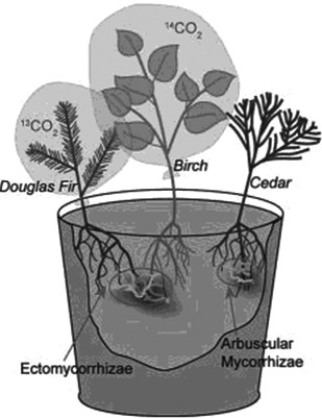Use the following information to answer the question.
Suzanne Simard and colleagues knew that the same mycorrhizal fungal species could colonize multiple types of trees. They wondered if the same fungal individual would colonize different trees, forming an underground network that potentially could transport carbon and nutrients from one tree to another (S. Simard et al. 1997. Net transfer of carbon between mycorrhizal tree species in the field. Nature 388:579-82) .
Pots containing seedlings of three different tree species were set up and grown under natural conditions for three years (Fig. A) . Two of the three species (Douglas fir, birch) could form ectomycorrhizal connections with the same fungal species, but the third species (cedar) could not form an ectomycorrhizal connection with the fungal species. In some of the pots, the researchers placed airtight bags over the Douglas fir and birch seedlings and injected carbon dioxide made from carbon-13 into the bags with the Douglas fir and carbon dioxide made from carbon-14 into the bags with the birch. (13C and 14C are different isotopes of carbon that can be detected and measured by researchers.) As the seedlings photosynthesized, the carbon dioxide was converted into sugars that could be tracked and measured by the researchers. The researchers measured whether the sugars in each plant contained only the carbon isotope that was in the air of their plastic bag or also the carbon isotope from the air around the other plant.
Figure A
Referring to Simard et al. (1997) , which design element is the control in this experiment and why?
Definitions:
Bond Financing
A method of raising capital through the issuance of bonds which are to be repaid at a specified maturity date along with periodic interest payments.
Q9: Additional vascular tissue produced as secondary growth
Q12: At one time, Chondrichthyes were thought to
Q15: Which of the following is a defining
Q38: The phase change of an apical meristem
Q46: Suppose you traveled back in time and
Q47: When you eat Brussels sprouts, you are
Q47: Moss sporophytes are typically green when young,
Q53: In a meristematic region, the cell plate
Q56: The fact that both charophytes and green
Q69: Imagine that a phylogeny was developed for